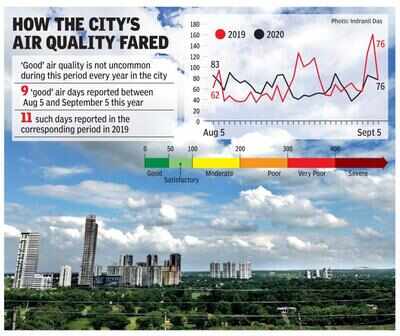
Gurgaon: Heavy rain, high humidity levels and low vehicular traffic have ensured that the city breathed cleaner air in the past one month. Between August 5 and September 5, the city has had nine good air days, when the air quality index (AQI) was below 50. On other days, too, the air quality hovered around the moderate level — clocking between 50 and 100. On Sunday, the AQI was 56.
But officials, however, warned that pollution levels could rise again in the coming days with vehicles returning to the streets as usual. With the harvesting season also nearing, it has raised concerns about stubble burning, a major contributor to Delhi-NCR’s deteriorating air quality during the winters.
Good air days during this time of the year are not a departure from the usual. Last year, too, the city had nine good air days in September. In 2018, there were three days in September when the AQI was below 50. Those were the only good air days that year. This year, the city’s three cleanest days were on August 20, 21 and September 1, when the air quality level was 44, 40 and 46, respectively.
This year’s data was compiled from three air quality monitors installed by the Haryana State Pollution Control Board (HSPCB) at Vikas Sadan, Teri and Sector 51. Among the three stations, Teri had the lowest AQI on most days, which is because of the greenery around it. In contrast, the Sector 51 station in the heart of the city saw the highest AQI on most days.
On an average, air quality levels have been better in the first week of September in comparison with August. Officials said much of it had to do with the above-average rain the city received. “Yes, the air quality has been satisfactory because of the rain. High levels of humidity have also played a role,” an HSPCB official said.
Asked about the trend, MD Sinha, who heads the urban environment wing of GMDA, said, “The AQI has been below 100 almost every day for the past month. According to our observation, the air was the cleanest on August 31.” GMDA uses its own air quality monitors to record and analyse pollution data. So, there is a little difference between the data of the development body and that of the pollution board.
Apart from climatic factors, low vehicular traffic during the lockdown also aided cleaner air levels in the city. Industries had been closed and construction activity stalled during this period, which otherwise push up pollution levels considerably.
Singh alerted that air quality might deteriorate again with the resumption of construction activities. With Metro services hitting the track from this week, diesel auto-rickshaws are likely to be back on the streets and pollute the air. Farmers are also expected to resort to stubble burning at the end of the harvesting season.
A Central Pollution Control Board study had revealed that diesel generators contribute to 6% of PM 2.5 emissions and 10% of PM10 across Delhi-NCR.
Although diesel gensets had been functioning in the city even during the lockdown, diesel autos are a cause for concern. Once Metro services resume, autos will start ferrying commuters to stations.
But officials, however, warned that pollution levels could rise again in the coming days with vehicles returning to the streets as usual. With the harvesting season also nearing, it has raised concerns about stubble burning, a major contributor to Delhi-NCR’s deteriorating air quality during the winters.
Good air days during this time of the year are not a departure from the usual. Last year, too, the city had nine good air days in September. In 2018, there were three days in September when the AQI was below 50. Those were the only good air days that year. This year, the city’s three cleanest days were on August 20, 21 and September 1, when the air quality level was 44, 40 and 46, respectively.
This year’s data was compiled from three air quality monitors installed by the Haryana State Pollution Control Board (HSPCB) at Vikas Sadan, Teri and Sector 51. Among the three stations, Teri had the lowest AQI on most days, which is because of the greenery around it. In contrast, the Sector 51 station in the heart of the city saw the highest AQI on most days.
On an average, air quality levels have been better in the first week of September in comparison with August. Officials said much of it had to do with the above-average rain the city received. “Yes, the air quality has been satisfactory because of the rain. High levels of humidity have also played a role,” an HSPCB official said.
Asked about the trend, MD Sinha, who heads the urban environment wing of GMDA, said, “The AQI has been below 100 almost every day for the past month. According to our observation, the air was the cleanest on August 31.” GMDA uses its own air quality monitors to record and analyse pollution data. So, there is a little difference between the data of the development body and that of the pollution board.
Apart from climatic factors, low vehicular traffic during the lockdown also aided cleaner air levels in the city. Industries had been closed and construction activity stalled during this period, which otherwise push up pollution levels considerably.
Singh alerted that air quality might deteriorate again with the resumption of construction activities. With Metro services hitting the track from this week, diesel auto-rickshaws are likely to be back on the streets and pollute the air. Farmers are also expected to resort to stubble burning at the end of the harvesting season.
A Central Pollution Control Board study had revealed that diesel generators contribute to 6% of PM 2.5 emissions and 10% of PM10 across Delhi-NCR.
Although diesel gensets had been functioning in the city even during the lockdown, diesel autos are a cause for concern. Once Metro services resume, autos will start ferrying commuters to stations.

Coronavirus outbreak
Trending Topics
LATEST VIDEOS
City
 Shocking: 20-year-old Covid-19 patient raped by ambulance driver enroute to hospital in Kerala
Shocking: 20-year-old Covid-19 patient raped by ambulance driver enroute to hospital in Kerala  Daughters of this country will never forgive you, Kangana Ranaut hits back at Sanjay Raut
Daughters of this country will never forgive you, Kangana Ranaut hits back at Sanjay Raut  Sushant Singh Rajput death probe: CBI quizzes ambulance driver, asks 'Why Sandip Ssingh called him on June 16'?
Sushant Singh Rajput death probe: CBI quizzes ambulance driver, asks 'Why Sandip Ssingh called him on June 16'?  Procured drugs on Showik's instructions, Sushant's staffer Dipesh Sawant makes big revelation
Procured drugs on Showik's instructions, Sushant's staffer Dipesh Sawant makes big revelation
More from TOI
Navbharat Times
Featured Today in Travel
Quick Links
Kerala Coronavirus Helpline NumberHaryana Coronavirus Helpline NumberUP Coronavirus Helpline NumberBareilly NewsBhopal NewsCoronavirus in DelhiCoronavirus in HyderabadCoronavirus in IndiaCoronavirus symptomsCoronavirusRajasthan Coronavirus Helpline NumberAditya ThackerayShiv SenaFire in MumbaiAP Coronavirus Helpline NumberArvind KejriwalJammu Kashmir Coronavirus Helpline NumberSrinagar encounter
Get the app



